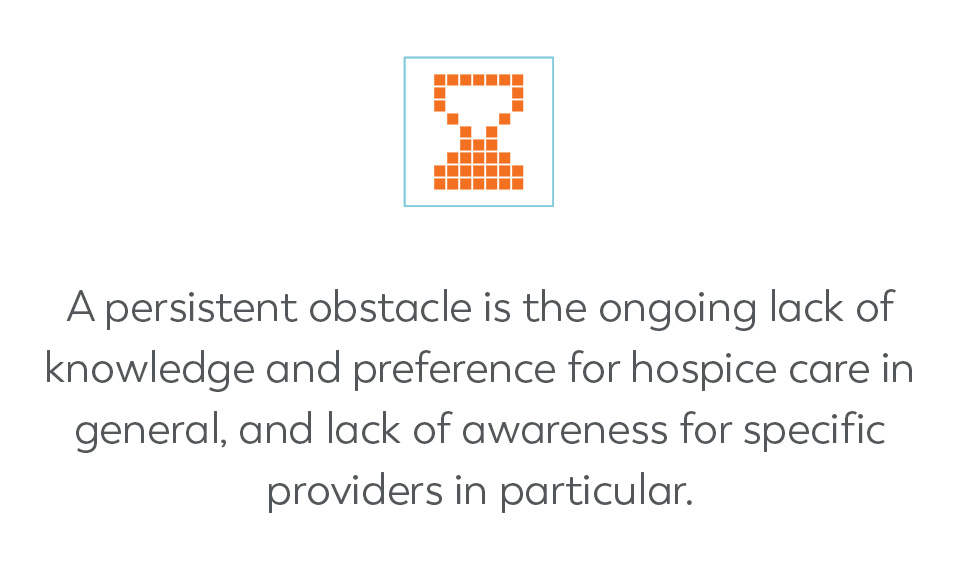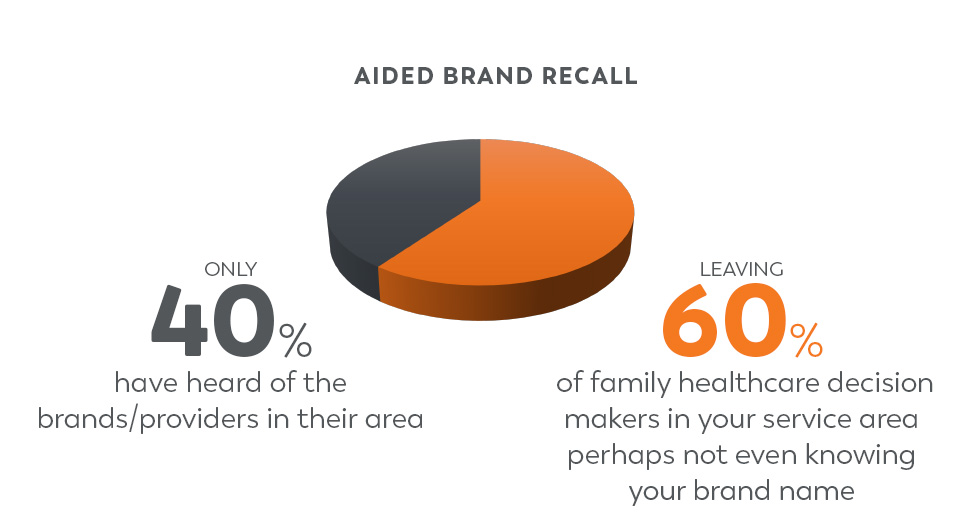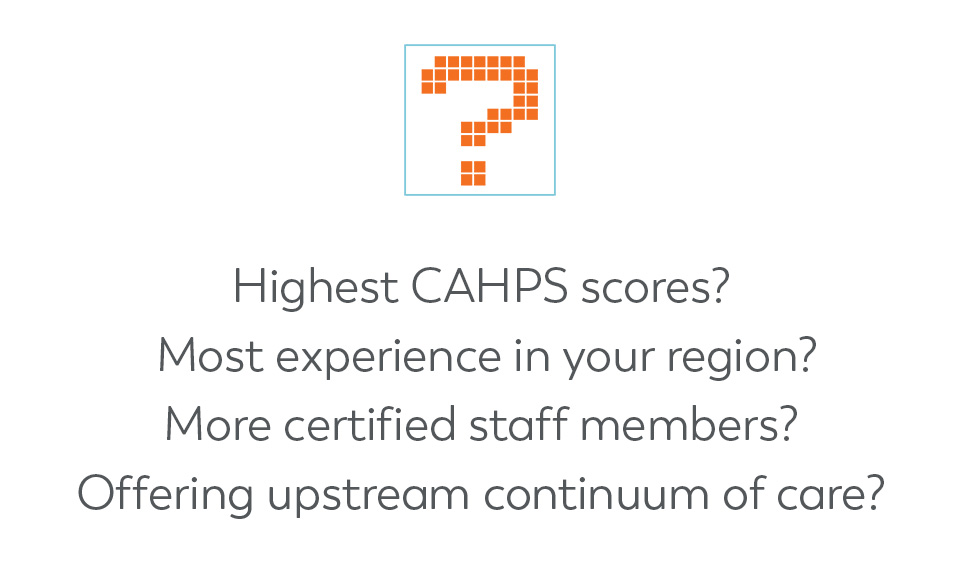Why You Need to Keep Hammering at Brand Awareness
A lot has changed in healthcare during the past 20 years – especially for providers of healthcare at patients’ homes. Driving much of that change has been the impact of shifting reimbursement models. The last two decades have seen continuous tweaks or even major overhauls to Medicare reimbursements, including hospice payment revisions, the introduction of PDGM for home health and the growing influx of managed care plans.
One thing that has stubbornly refused to change much at all, however, is the general public’s perceptions of hospice care and hospice providers. When the company that is now Transcend Strategy Group was founded 20 years ago, it was based largely on our first survey of family healthcare decision makers regarding end-of-life care and hospice awareness.
We have been steadfast in continuing those surveys as a cornerstone to our work with providers across the nation. Now, 20 years later and counting, we have amassed data from more than 25,000 family healthcare decision makers – whom we always have defined demographically as adults, age 45+, skewed toward women.

A persistent obstacle is the ongoing lack of knowledge and preference for hospice care in general, and lack of awareness for specific providers in particular.
Why does this barrier refuse to soften? Let’s face it – our society doesn’t like to think about serious illness, let alone dying. The need for hospice rarely makes it to an American’s radar until the demand is glaring, which means our fellow citizens usually seek end-of-life care much later than they should (if at all) and often amidst crisis conditions.
And that mindset may even get worse instead of better. With the continuing advances of medical science, families and their loved ones’ doctors may prolong seeking another treatment, another clinical trial, another glimmer of curative hope before turning to hospice care during the very last days or hours of life.
So, at this 20-year milestone, let’s take a look at some key data trends that define this obstacle … and why it’s more important than ever to keep assertively educating audiences about your brand of hospice care.
Disappointing data can be the catalyst for improvement.
Our surveys ask participants about where they would turn for help or advice if a loved one was coping with a chronic serious illness. Unaided, only about 20 percent mention hospice. When asked directly if they’ve heard of hospice, 95 percent say they have. So that 75 percent gap in being aware of hospice but not having it top-of-mind is significant – and disappointing.
The lack of knowledge and awareness about specific hospice providers is even more severe. When the survey asks participants to name providers of hospice care in their community, we typically see that 10 percent or fewer can correctly name a single hospice brand. Getting the brand name exactly right can be very important. We’ve seen multiple instances where families thought they were requesting a hospice named after their region – for instance, Hospice of Jones County – and instead were referred to a hospice operating in the same area. Of course, there’s a difference between Hospice of Jones County and other hospices in Jones County.
 With aided recall – that is, when survey participants are read a list of hospice providers in their area – still only about 40 percent admit they have heard of the brands. So, going by national averages, about 60 percent of family healthcare decision makers in your service area may not even know your brand name.
With aided recall – that is, when survey participants are read a list of hospice providers in their area – still only about 40 percent admit they have heard of the brands. So, going by national averages, about 60 percent of family healthcare decision makers in your service area may not even know your brand name.
Dozens of focus groups we’ve conducted with this same target audience reveal the source of this confusion. As many of you hospice providers likely have experienced for yourselves, consumers tend to have an extremely generic view of hospice. Often, they are surprised to learn that there’s more than one hospice provider in their community. Over the years, I’ve heard consistent comments like these from focus groups around the country:
- “Hospice is run by the government.”
- “Every county has a hospice ‘chapter’ – kind of like the Red Cross.”
- “When it’s time, you go to the hospice chapter in your county” (which implies hospice is a place).
Of those who are aware that there’s more than one hospice provider, they are hard pressed to tell you any differences among them. Only 10 percent of respondents who know of more than one provider say they can name a difference. By far, the number one difference cited is location – which has nothing to do with the continuum of care or quality of service provided – and again implies that hospice is a place, not a philosophy of care.
Keep hammering on your brand for awareness and differentiation.
What can you do about this persistent and perplexing problem? In short, market assertively and consistently in ways that tie much-needed education about hospice care to your exact brand.
Also, prioritize family healthcare decision makers as a primary target audience. Since the origins of hospice in this country, conventional wisdom has said that hospice providers should market to healthcare professionals because that’s where most referrals come from. However, hospice care is one part of the healthcare continuum where patients and families can refer themselves – and most hospice providers have missed this opportunity. Instead, they battle their competitors going after the same referral sources in much the same way, which often fragments a market.
During the past 20 years, Transcend has helped our clients target family healthcare decision makers with an emphasis on family caregivers. The results have been exceptional. We’ve shown that appealing to family caregivers often can prompt not only more self-referrals, but also sparks earlier calls for help with caring for patients at home … leading to significant increases in both ADC and LOS.
We’ve strategically used all the tools in the marketing toolbox to reach the consumer audience effectively. Mass media such as TV, radio and outdoor still are powerful ways to quickly build overall brand awareness. And now, the incredible targeting abilities of digital and social media help customize meaningful messaging and get those messages to audiences when they’re most relevant. Best of all, the engagement of digital and social media is highly trackable, allowing us to see what is working best and make any necessary adjustments quickly.
 As you build awareness for your brand, make sure to differentiate, too. While the tone of your marketing should convey the empathy and compassion of your team, more quantifiable proof points can be convincing differentiators. Do you have CAHPS or other family satisfaction scores higher than your competitors? Do you have the most experience in providing hospice care for your region? Do you have more staff members certified in hospice and palliative care? Do you offer a broader continuum of care upstream from hospice?
As you build awareness for your brand, make sure to differentiate, too. While the tone of your marketing should convey the empathy and compassion of your team, more quantifiable proof points can be convincing differentiators. Do you have CAHPS or other family satisfaction scores higher than your competitors? Do you have the most experience in providing hospice care for your region? Do you have more staff members certified in hospice and palliative care? Do you offer a broader continuum of care upstream from hospice?
By keeping a very consistent presence through targeted, strategic marketing and education for family caregivers, your brand can build awareness and preference over time. Transcend’s flagship client, Hospice of Northwest Ohio, has been following these principles faithfully since 2002. Their unaided brand awareness has grown to 75 percent (remember the national average is 10 percent or less) and they continue to dominate hospice market share despite the presence of a hospice program from their region’s major healthcare system.
Want more insights driven by data?
Stay tuned to our blog and website for an upcoming deeper dive into key insights we’ve gained from 20 years of senior care surveys – and the opportunities those insights can reveal for your organization.







